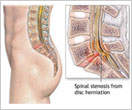Spinal cord stimulation, or dorsal column stimulation, is an advanced medical technique that is used when medications, physical therapy, and injections prove ineffective in alleviating neural pain in the back, arms, or legs. The procedure has two phases, and utilizes a special device that transmits electrical impulses directly onto spinal nerves. Upon implantation, patients who respond well to treatment will feel a tingling sensation and experience immediate pain relief. Doctors believe that electrical impulses are able to prevent pain signals from being sent to the brain. Candidates for this procedure include people with failed back syndrome, acute peripheral neuropathy, complex regional pain syndrome, nerve root compression, and degenerative disk disease.
The first phase of the procedure is designed to determine how individuals responds to electric stimulation on spinal nerves. An estimated 60% of patients will experience the targeted anesthetic effect during the first stage, and are subsequently recommended for permanent implantation. Initially, patients will be given a local anesthetic to decrease the discomfort associated with the primary needle insertion. Valium is also provided for sedation and relaxation. When the patient is comfortable, an epidural needle is inserted into the epidural space on the spine. Attached to the needle are one or more insulated wire leads, which are connected to an external stimulator through small openings in the skin. The stimulator is a device that controls the level of electrical impulses being transmitted onto the nerves. Live X-ray, and patient feedback, will allow for accurate wire placement on the spinal cord.
Upon the completion of the procedure, the temporary spinal cord stimulator will be used for three to seven days to test its effectiveness. The doctor will determine if a permanent implantation is warranted, based on the amount of pain relief an individual experiences during the trial period. At the end of the assessment, the spinal cord stimulator wires are quickly and painlessly removed by the clinician.
If the patient and physician agree that a permanent spinal cord stimulator is necessary, a more invasive procedure is required. Typically, patients undergo general anesthesia in an operating room setting. During surgery, the device is implanted with a special battery, an internal controller, and one or more permanent insulated wires that are positioned on pre-assigned locations in the epidural space of the spine. The procedure usually takes an hour and a half to complete, with time afterwards for observation and rest. Patients are still able to turn the device on and off, and control the amount of electrical impulses via an external radio frequency controller.






